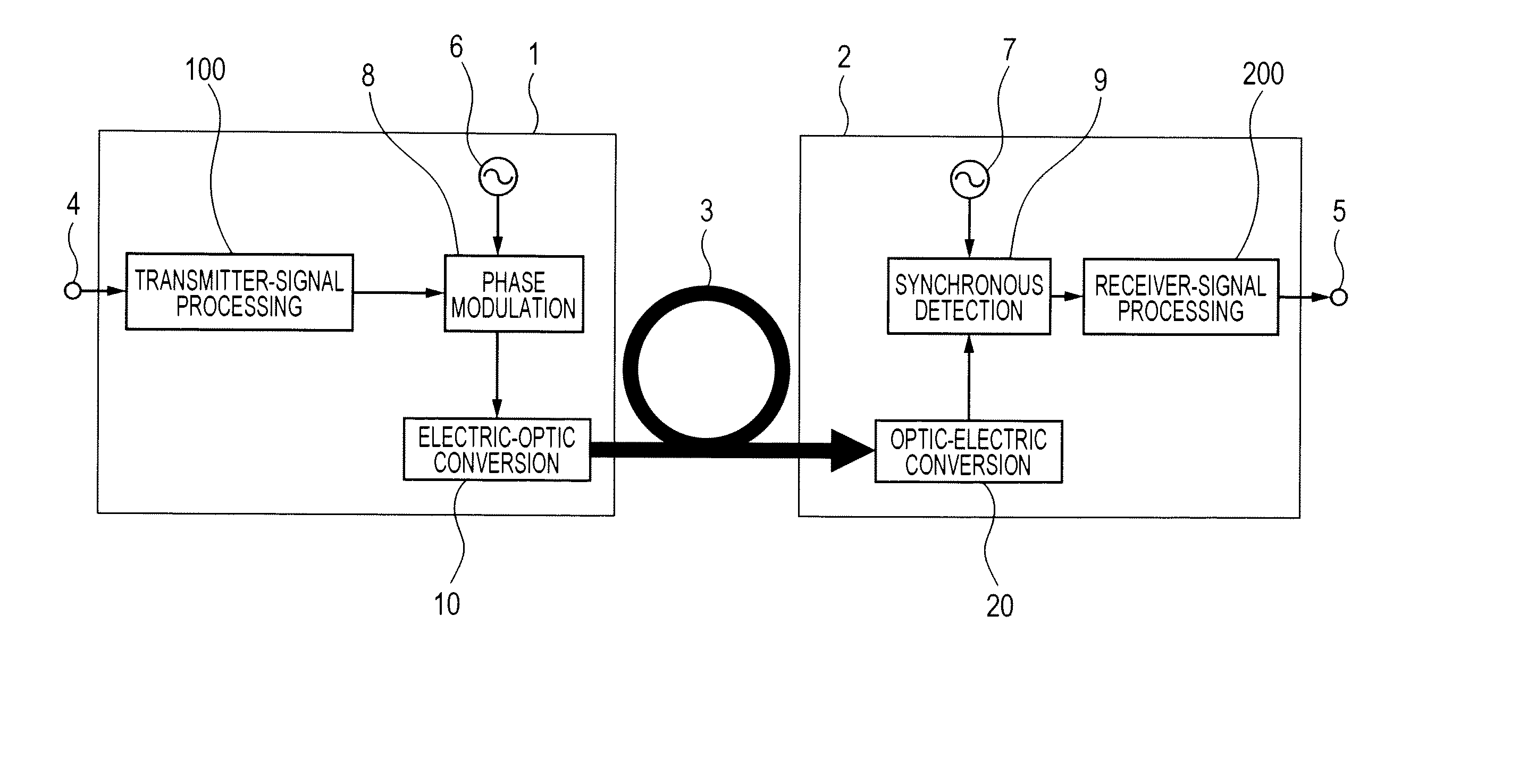Optical communication system, optical transmitter, optical receiver, and optical transponder
- Summary
- Abstract
- Description
- Claims
- Application Information
AI Technical Summary
Benefits of technology
Problems solved by technology
Method used
Image
Examples
first embodiment
2. First Embodiment
[0071]A first embodiment will now be described with reference to FIG. 1, etc. Although it is assumed that the subcarriers are modulated using 4-QAM for exemplary purposes, the present embodiment is not limited thereto, and any subcarrier modulation method can be used. Furthermore, the number of the subcarriers is designated as N (N is an integer).
[0072]FIG. 1 shows the configuration diagram of an optical OFDM communication system.
[0073]The optical OFDM communication system includes, e.g., a transmitter (optical transmitter) 1, an optical fiber 3, and a receiver (optical receiver) 2. The transmitter 1 includes, e.g., a transmitter-signal processing unit 100, an RF oscillator 6, and an electro-optic converting unit10. The transmitter 1 may also have an input terminal 4. The receiver 2 includes an opto-electric converting unit 20 and a receiver-signal processing unit 200. The receiver 2 may also have an output terminal 8. The transmitter 1 and the receiver 2 are conn...
second embodiment
3. Second Embodiment
[0085]A second embodiment will now be described with reference to FIG. 8, etc. FIG. 8 shows a system configuration diagram according to the second embodiment. It differs from the first embodiment in that a narrow-band optical filter 14 is installed at the optical output of the electro-optic converting unit 10 in the transmitter 1-4. The narrow-band optical filter blocks a sideband wave of the optical signal output from the electro-optic converting unit 10, thus generating an optical SSB (Single Side Band) signal. Optical SSB signals are known to generate no waveform distortions due to the wavelength dispersion property of optical fibers, and are therefore suitable for long-distance communication systems.
[0086]The electro-optic converting unit 10 in the second embodiment may be a unit 10-2 shown in FIG. 6 or a unit 10-3 shown in FIG. 7, while the opto-electric converting unit 20 may be a unit 20-1 shown FIG. 5.
[0087]As another means for generating the optical SSB ...
third embodiment
4. Third Embodiment
[0091]A third embodiment will now be described with reference to FIG. 13. FIG. 13 is an overall configuration diagram of a communication system according to the third embodiment.
[0092]A receiver 2-3 according to the third embodiment includes e.g., an opto-electric converting unit 20-2, an RF oscillator 7-1, a synchronous detecting unit 9, a receiver-signal processing unit 200, a local oscillator semiconductor laser 50, and an optical combining unit 60. An optical signal transmitted from a transmitter 1 through an optical fiber 3 enters the receiver 2-3. This optical signal is combined with light output from the local oscillator semiconductor laser 50 installed in the receiver 2-3, and is received by the opto-electric converting unit 20-2 using the so-called coherent receiving method so as to be converted into an electric signal. This electric signal is synchronously detected by the synchronous detecting unit 9 using a sinusoidal wave output from the RF oscillator ...
PUM
 Login to View More
Login to View More Abstract
Description
Claims
Application Information
 Login to View More
Login to View More - R&D
- Intellectual Property
- Life Sciences
- Materials
- Tech Scout
- Unparalleled Data Quality
- Higher Quality Content
- 60% Fewer Hallucinations
Browse by: Latest US Patents, China's latest patents, Technical Efficacy Thesaurus, Application Domain, Technology Topic, Popular Technical Reports.
© 2025 PatSnap. All rights reserved.Legal|Privacy policy|Modern Slavery Act Transparency Statement|Sitemap|About US| Contact US: help@patsnap.com



